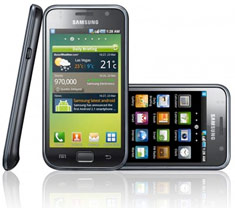Speed Bump: Samsung’s Galaxy Phone Gets Upped to 4G

It’s official: 2011 is the year of incremental progress. Mobile handsets have settled into a groove featurewise and are now gently nudging their way upward in speed, power and capabilities.
If we’re going to be stuck in a climate of baby steps, at least Samsung’s Galaxy S 4G is an example of baby steps done right.
From the moment I got my mitts on the S 4G, something felt eerily familiar. I’d seen many of its elements before — the unsettlingly light chassis, the glass and faux-chrome accents, and even the flashless 5-MP camera. As it turns out, the feeling of déjà vu was completely warranted.
The S 4G is essentially a mildly tweaked
Samsung Vibrant with a couple of extra goodies. For those keeping score, a lot of the Vibrant’s perfectly serviceable features (1-GHz processor, 4-inch 800 x 480 AMOLED screen, 720p video recording) are back.
So, what’s new? Android 2.2, for starters. Also, as the phone’s awkward moniker boasts, this handset brings T-Mobile’s
particular brand of 4G (HSPA+) to the fold.
I honestly wasn’t expecting too much given the piecemeal rollout of this next-gen data network, but the difference was noticeable immediately. Heavy hitting image-rich sites like (ahem) Wired.com loaded with virtually no hesitation, and raining down large file downloads from Dropbox produced nary a stutter.
Converting the phone into a hot spot was also one of the more useful data-centric features, though the option is strangely buried within the menu tree.
Samsung’s TouchWiz user interface has never been especially appealing, and this is another nail in that coffin.
Yet another addition is the S 4G’s front-facing VGA camera. Though it’s perfectly poised for video conferencing, I was a little underwhelmed by the options on the app side. Getting the service up and running is simple enough thanks to a
preloaded Qik app, but the occasional stutter and noticeable lag left a lot to be desired.
Lack of polish aside, I can’t really fault the VGA camera in terms of functionality. I was able to make and receive video calls just fine. They just resembled fireside chats with Max Headroom.
Other goodies include a copy of
Inception offered from Samsung’s
Media Hub storefront. Normally I’m prone to ignore extras like this entirely, but watching the film on the S 4G uncovered some interesting tidbits. Due to the smart combination of a workhorse battery and a power-sipping display, the film’s hefty 2-hour-28-minute run time only slightly dented the Galaxy’s gas tank.
As the movie finished I noticed that only 20 percent of the battery had been depleted. It’s doubtful that I would ever force myself into a back-to-back four-peat viewing of
Inception, but it’s good to know that Samsung realistically views the S 4G as an entertainment device.
If we’ve learned anything over the past year, it’s that
incremental improvements are incredibly easy to flub. Even with our lingering gripes with the S 4G, we can’t give the phone too much guff.
Samsung managed to transform an already well-appointed blueprint into an even stronger contender. Sure, it’s not the overwhelmingly overhauled quad-core beast of our dreams. But even incremental progress still counts as progress.
WIRED Stronger iteration of a solid design. Mostly smooth navigation thanks to a humming 1-GHz processor. Great call quality. Awesome battery life and power management. Gorgeous high-def 720p video (in well-lit environments). Ready for downloads and app-tion thanks to an included 16-GB memory card (expandable to 32 GB).
TIRED Accessing the movie storefront requires a tedious login process. Bloatware aplenty. Where’s my HDMI out? HSPA+ service is fantastically fast (where available). 4G to 3G to EDGE handoffs are often slow. White backgrounds often produce the dreaded “screen-door effect.” Froyo is already old hat — give us Gingerbread!











